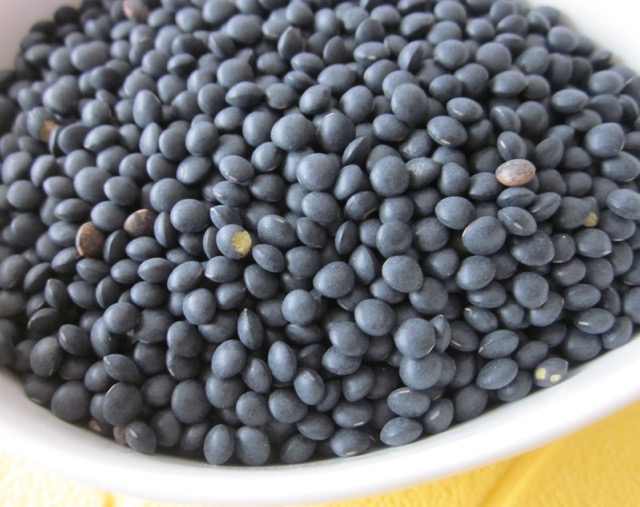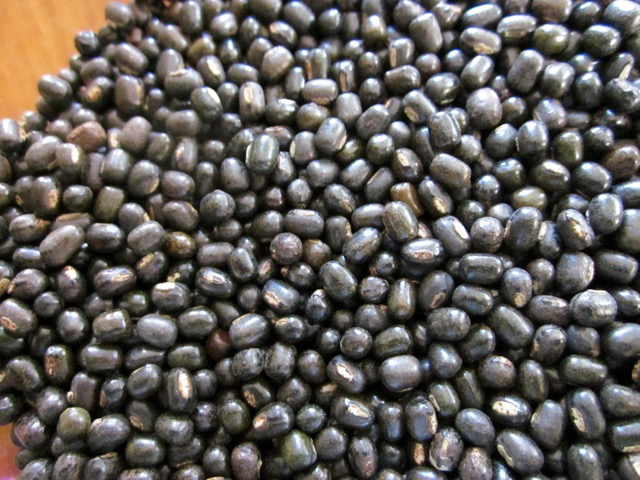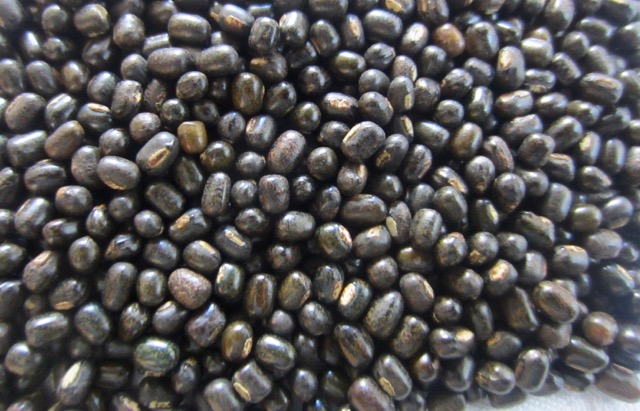Vigna mungo (L.) Hepper
Bean Family leguminosae (Fabaceae)
Common Names: Black gram, Urad dal, urd bean, urad bean, minapa pappu, black matpe bean, mungo bean or Haricot urd, urd (French). Feijão urida (Portuguese). Mchooko mweusi (Swahili).
Urad dal or black gram are the black seeds of the leguminous plant called Vigna mungo. It’s mainly grown in India and used to make the Indian soup commonly known as ‘Dal‘
Below is a photo of Whole Black Gram also marketed as Sabut Urad Dal
Below is a photo of whole black gram (Urad Dal) with Skin, whole skinless black gram, and split black gram with skin.
Black gram can be sold whole with skin, whole skinless, split with skin or split without skin.
Where is Black Gram Grown?
Black gram is mainly grown in India, and to some extent throughout tropical Asia. It’s also grown in some countries in Africa. In the US and Australia it’s mainly grown as a fodder crop. India is the major producer and consumer of black gram. (PROTA)
Important Points to Note

Whole black gram (Vigna mungo) is sometimes marketed as black lentil but it’s not a lentil.
Please do not confuse black gram with Black beluga lentils (Lens culinaris) see the picture on the right.
Also the split grams without skin may sometimes be marketed as white lentils but again, it’s not a lentil (Lens culinaris).
In general black gram may be called black lentils or white lentils but it’s not a lentil. It’s a gram.
Nutrition of Black Gram
Black gram is very rich in protein and carbohydrate. It also has a good amount of folate vitamin B9), iron, magnesium and phosphorus. Its very nutritious.
100g 3.5oz black gram has about 8.6g water, 351 calories, 25.1g protein, 1.8g fat, 61g carbohydrate and a fair amount of B-vitamins.
100g 3.5oz provides the following Recommended Daily Allowances (RDA): Folate (B9) 54%, Iron (58%), Magnesium (75%), Phosphorus (54%) and Zinc (35%)
Culinary use of Whole Black Gram (Sabut Urad Dal)

Black gram is popular in Northern India where the bean is boiled and eaten whole. It can also be be split and made into Dal (black gram soup).
The whole gram has an unusual mucilaginous texture, more like cooked oatmeal.
To cook the whole gram, it is best soaked overnight and cooked slowly over low fire until it’s falling apart.
With modern advancements, it is now mostly cooked using a pressure cooker.
The whole gram is very popular in the Punjabi cuisine where it’s used to make Dal Makhani (Dal Makhni). The primary ingredients are whole black gram (Urad Dal), red kidney beans (rajma), butter and cream. It can also be prepared with yoghurt or dairy instead of cream.
Black gram can also be used as a seasoning. A teaspoon or two is sautéed in hot ghee at the beginning of cooking to give a nutty flavour, add texture and thicken the dish.
Culinary use of Split Black Gram with skin (Chilka Urad Dal)

The split black gram is also known as Chilka Urad dal. It does not requite soaking but can be soaked for 30 minutes only, otherwise, the skin might come off.
It’s used to make Dal (black gram soup). The split gram is first boiled with turmeric and salt and then different seasonings (tadka) are made using different ingredients. Tadka is added just before serving the soup, to flavour it. This process of making tadka (seasoning) is called tempering.
Whole Skinless Black Gram (Urad Dal)

The whole skinless black gram is used as a key ingredient in making the idli-dosa batter. The batter is madeby mixing one part of skinless black gram with three or four parts of idli rice. The mixture is ground with a little water to make a thick batter that is fermented before use. (see how to make dosa batter at home-Ruchi’s Vegetarian Kitchen)
Also the batter for vada or udid vada is made by soaking whole skinless urad dal and then grinding it with a little water to form a thick batter. The batter is mixed with other spices and deep fried in cooking oil. (See Malinis Space-Vada Recipe)
The skinless whole gram is a key ingredient in making batter for several other recipes. It’s made by soaking rice and skinless gram and grinding them into a batter, then fermenting. (see three different breakfast recipes)
Black gram flour (Urad Atta): is made into ‘papadum’ (a crispy indian cracker usually served as an appetizer or with drinks in Indian restaurants). I have always wondered how they are made and today I found a very good you-tube video on how to make papadum (Papa). I think I’m going to try it some time next week. How exciting!
The skinless whole Urad dal can also be made into dal (back gram soup).
Here is how to make Urad Papadum
Here are the other Uses of Black Gram
Black gram is exported to Japan to make black gram seed sprouts. (PROTA)
The green immature pods are eaten as a vegetable.
The Pods and foliage (leaves) can be used to supplement cattle feed or used as forage-pods to feed to cattle after the black seed is removed.
Black Gram Flour is used as a substitute for soap. It makes the skin soft and smooth (PROTA)
Black gram seeds are sometimes sown as a cover crop or for green manure.
Black gram is closely related to Green Gram (Mung Dal)

Black gram is closely related to green gram but they are different in colour and taste as well as nutrition and use. Both are used to make Dal (soup).
Botanical Notes
Three taxa are distinguished within Vigna mungo: (PROTA)
- var. mungo, with large, black-seeded and early-maturing cultivars
- var. viridis Bose, with greenish dull or glossy seeds and late-maturing cultivars
- var. silvestris Lukoki, Maréchal & Otoul, the wild type. Compared to cultivated types it is smaller, more climbing, more hairy, with denser inflorescences and small seeds with prominent raised aril; it is considered the ancestor of the cultivated black gram.
- For cultivated types a classification into cultivars and cultivar groups would be more appropriate.
A summary of the edible Vigna species
- Vigna radiata (L.) R. Wilczek. also known as Mung Bean, Moong Bean, Green Gram, Golden Gram, Haricot mungo, Mungo, haricot doré
- Vigna mungo (L.) Hepper also known as black gram, urad bean, minapa pappu, mungo bean or black matpe bean. V.mungo and V. radiata are very closely related.
- Vigna umbellata (Thunb.) Ohwi & H.Ohashi also known as rice bean.
- Vigna aconitifolia (Jacq.) Maréchal. It is commonly called mat bean, moth bean, matki, Turkish gram or dew bean.
- Vigna angularis (Willd.) Ohwi & H. Ohashi : Adzuki bean, Aduki Bean or Azuki Bean
- Vigna unguiculata (L.) Walp. Also known as: Black Eyed Pea, Cowpea, Pea Bean, Black Eyed-Bean, China Pea, Bombay Cowpea. Southern Peas, Black eye Peas, Crowder Peas, California blackeyed pea. Also includes the yardlong beans.
myfavouritepastime.com Last Updated: July 01 2019




when searching for Black Gram to purchase I am only finding Black lentils can you suggest a certified non-gmo organic brand
Thanks
Unfortunately I do not know.
Thanks Liz
I’m trying to find out what the amino acid profile is for matpe bean (black gram) particularly the arginine and lysine content. Can you help?
No I can’t but if I come across it, I will let you know!
Liz
Here you go
https://www.mohanfoundation.org/calories_in_indianfood/Essential_Amino_Acids/Pulses_and_legumes.asp
Thank you so much Robhiengler. This is very useful information. Best wishes!
Liz
Here you go:
https://www.mohanfoundation.org/calories_in_indianfood/Essential_Amino_Acids/Pulses_and_legumes.asp
Try the USDA website
https://fdc.nal.usda.gov/fdc-app.html#/
I hope the link helps
Liz
Very informative
Thanks!
Liz
Great Post. Very informative.
Thank you
Liz
how fascinating! That papadam video was great!
I really loved that video. I’m planning to make some papadum. I was so mesmerized because I never knew how they’re made!!!
Liz
At first I was thinking a black adzuki? Great article.
Thank you
Liz
Great post on urad dal !
Thanks
Liz